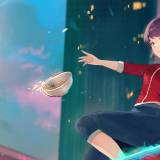I’ll admit to never touching a Prince of Persia game before in my life. Which is probably good in the case of this review as the newest PoP is so different compared to its predecessors. Complimented by a completely new art direction and its easier style of gameplay, has Ubisoft given PoP the refresh fans were looking for? Or has the attempt to widen the core audience by removing the “game over” screens done more damage than good?
After loosing your recognisably named Donkey ‘Farah’ and getting caught up in some father daughter conflict, you’re suddenly thrown into a dark and barren world slowly being corrupted by Ahriman, the God of Darkness, and his followers. Your mission is to trap Ahriman back into the temple by restoring the corrupted lands with Elika, the Princess and your new companion.
You’ll begin with only 4 areas to access and each area is clustered together in a region: Veil, the Citadel, the City of Light, and the Royal Palace. After healing a section in an area you open another path attached to it and after learning new powers you can cross between different regions.
By just rushing through the game you’ll learn hardly anything about this world, Elika or Ahriman. Interacting with Elika after various cut scenes will open up more information on the world and your part in it, but having to constantly nag Elika to get information becomes particularly frustrating. Most of the time you’ll have to go through 3 or 4 ‘banter’ dialogues between the Prince and Elika before she’ll reveal more about the world, and while a lot of the dialogue is charming and entertaining it does drag on. I would have rather been treated to an entertaining cut scene rather than the same close up of Elika and the Prince with their repetitive mouth flaps and hand gestures.
The Prince’s character is dramatically different from what fans would have expected from previous titles. He sometimes feels more like the side character, in the grand scheme of things, rather than the main hero. Adding in some flirty and humorous dialogue during your run of the world, or in one of the many conversations you undertake with Elika, you begin to either love or hate the prince. His overly American voice and swagger (who also featured as the voice of Drake in Uncharted), while entertaining, can deter from the overall theme of the game. Little is revealed about his character and only what you hear turns out to be very depressing. Prince of Persia has been set up to have a sequel, so it’s only a matter of time before we learn more about the new Prince, but it’s a shame so little is revealed about him this time around.
The main factor of Prince of Persia will be getting from A to B, which is also the most enjoyable part of the game. Using the Prince’s extraordinary agility to jump, wall slide and shimmy his way around the world is a real thrill, especially when you have a good flow going. The game gently eases you into the very simple technique, but as you gradually get through the game learning wall run, jump, grab the ring and jump again as well as using the various power plates can be a real thrill. Elika will follow you, copying your exact movements and is also there to make sure to help you across longer jumps.
One of the many charming parts of this title is your small exchanges with Elika during your adventure. Whilst walking on a pole and you decide you need to go back to where you came from you will see the Prince and Elika holding hands and swinging round each other. Hanging from a ledge will also see you throw her to the opposite side, and from a high jump you can grab her. This really makes your relationship with Elika more human and believable and is certainly one of the many small details that make this game what it is.
The puzzles in the game are unnecessarily easy, and are usually solved in a matter of minutes without much thought. All of the puzzles are done with turning cranks, which gives a really lazy feel to the overall process of solving them. Waiting for Elika to come over to push the crank with you can also become a repetitive annoyance. Overall, they feel more like filler rather than a natural part of the game, and even though their existence is well woven into the storyline it all feels very forced and sadly very forgettable.
Unlike past versions, the Prince now only engages in one-on-one combat. You get a brief taster of this at the start with some of the guards chasing Elika, but most of your battles will take place against one of the 4 corrupted followers of Ahriman, as they attempt to stop you from healing the land. Each follower has a story as to why they joined Ahriman and this makes battles feel more worthy than slashing away at guard 1 and 2 over and over. Each battle feels like a boss fight which is strange seeing as the combat is very short lived.
You move around a small area and run down the health of the corrupted with combos and button mashing. The enemy will go through a variety of status’s requiring you to use a certain move first to counter. For example if the enemy becomes overwhelmed with corruption none of your attacks will work but throwing Elika toward them and a quick blast of magic will ease them out of that status and your chance to start a combo. All the battles feel repetitive and while some will enjoy chaining different combos, which only work on the easier boss fights, most battles will feel like a chore rather than a challenge.
The game’s emphasises is on collecting ‘light seeds’, which appear after you have healed a land. This is so Elika can learn new powers and give you access to new levels on the world map. You can restore the lands in any order you like, and with this open-world style you are encouraged to go back to previously healed lands to collect light seeds, marvel at the scenery, and even complete speed runs. The new powers are used only for travelling in the worlds and gaining access to other regions or even more light seeds. The powers work by Elika restoring magical plates by the temple. Jumping on the plate will either throw you across the sky, give you the ability to fly on a set path, let you speed run up and across walls or swing from one plate to the next. Using the plates and combining them really brings a good flow to the game, and getting a good rhythm becomes vital to later sections which require you to string together a number of jumps and swings before getting to your destination. Some combinations take some time to complete and can see you making simple mistakes without paying full attention to the environment.
This is where the decision to remove the “game over” screens really change what would be a frustrating game into a fun and challenging one. Missing a single ring grab on a large combo jump will see you only transported back to where you and Elika last touched solid ground, rather than taking you back to the start of the level. Any slips or falls along the way are quickly forgotten with Elika jumping to your rescue and popping you back to before you made your mistake. While the hardcore generally frown upon this kind of measure, Prince of Persia works very much on the same key as Assassins Creed and Mirror’s Edge – flow. Getting from A to B in a stylish, exciting and colourful manner is what brings Prince of Persia to life. Traversing through a corrupted land and then again through a healed version are both enjoyable and entertaining, and neither feel laborious. While playing through a corrupted level gives you a set path and reason for doing so, going back to collect light orbs really gives you the chance to explore and enjoy Prince of Persia’s fantastic animation and art work.
You can see that the game is asking to be enjoyed, not only as a fun adventure and platform title but also as a technical masterpiece in cell shading. When at a high point in the game, you marvel at the landscape below as you rotate the camera around you, the character detail and effort into creating such a magical and colourful world is really something to be appreciated. Certain areas of the game that really show off the environment even award the player with an achievement for enjoying the view. Yet another reason why the open world concept really does this game justice and going back to collect light seeds was more of an excuse to marvel at the beautiful surrounds than the task at hand.
If you’re looking for a charming, fun and relaxing title to sink some hours into after a hard day, then Prince of Persia is the one for you. This is not a title that’s going to challenge or compel you to replay over and over. While my play through was an enjoyable one the game was more about basking in the beautiful environments, pulling off a long flow of moves, and viewing the playful banter between Prince and Princess than a challenging platformer. With no difficulty settings, the game being short and only costume changes to reward you for your effort, some of you will feel short changed. However the story is filled with rewarding twists and turns making this adventure well worth your time.















